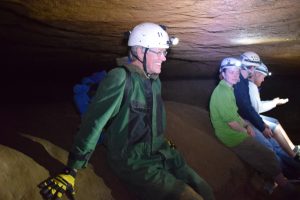Areas of Expertise: Ichthyology, Field Biology, Cave Biology
Bernie joined the TNACI staff in May 2012 after 25 years at the University of Alabama, where he managed a museum collection of 1 million specimens of preserved fishes from all around the world. Though his studies of fishes and other aquatic organisms have taken him around the United States, Mexico, and Central Asia, his particular expertise is surveying and monitoring threatened and endangered species from aquatic systems in the Southeast, in part to help evaluate the effectiveness of conservation programs. He currently teaches weekend courses at the University of Alabama Gadsden Campus and on the main campus in Tuscaloosa every summer. He serves on multiple USFWS Recovery Teams/Groups for endangered and threatened species.

Daily Uniform: A fish shirt, the louder, the better!
Favorite Part of My Job: Field work.
Education:
Ph.D., University of Alabama (Biology)
M.S., Southern Illinois University (Zoology)
B.S., Southern Illinois University (Zoology)
B.A., Southern Illinois University (Chemistry)
Representative Publications:
Huntsman, B.M., M.P. Venarsky, F. Abadi, A.D. Huryn, B.R. Kuhajda, C.L. Cox, and J.P. Benstead. 2020. Evolutionary history and sex are significant drivers of crayfish demography in resource-limited cave ecosystems. Evolutionary Ecology 34(2): 235-255. [link]
Fluker, B.L., K.D. Jones, and B.R. Kuhajda. 2019. Genetic structure and diversity of the Blueface Darter Etheostoma cyanoprosopum, a microendemic freshwater fish in the southeastern USA. Endangered Species Research 40:133-147. [link]
Cronnon, C.T., M. Harris, B. Kuhajda, and H. Klug. 2019. Behavior of Chrosomus saylori (Laurel Dace) during the breeding season. Southeastern Naturalist 18(3):373-380. [link]
Jordan, G.R., E.J. Heist, B.R. Kuhajda, G.R. Moyer, P. Hartfield, and M.S. Piteo. 2019. Morphological identification overestimates the number of Pallid Sturgeon in the lower Mississippi River due to extensive introgressive hybridization. Transactions of the American Fisheries Society 148(5):1004-1023. [link]
Elkins, D, S. Sweat, B. Kuhajda, A. George, S. Wenger. 2019. Illuminating hotspots of imperiled aquatic biodiversity in the southeastern US. Global Ecology and Conservation 19 (2019):e00654, 1-13. [link]
Farnsley, S. B. Kuhajda, A. George, and H. Klug. 2018. Learning to overcome a lack of evolutionary history: can an endangered fish learn to fear an introduced predator? Frontiers in Ecology and Evolution 6(214):1-7. [link]
Hurt, C., B. Kuhajda, A. Harman, N. Ellis, and M. Nalan. 2017. Genetic diversity and population structure in the Barrens Topminnow (Fundulus julisia): implications for conservation and management of a critically endangered species. Conservation Genetics 18(6):1347-1358. [link]
Kuhajda, B.R., and S.J. Rider. 2016. Status of the imperiled Alabama Sturgeon (Scaphirhynchus suttkusi Williams and Clemmer, 1991). Journal of Applied Ichthyology 32(Suppl. 1):15-29. [link]
Niemiller, M.L. K.S. Zigler, P.B. Hart, B.R. Kuhajda, J.W. Armbruster, B.N. Ayala, and A.S. Engel. 2016. First definitive record of a stygobiotic fish (Percopsiformes, Amblyopsidae, Typhlichthys) from the Appalachians karst region in the eastern United States. Subterranean Biology 20:39-50. [link]
Duncan, R.S., B.R. Kuhajda, C.A. Hodges, and A.L. Messenger. 2016. Population structure and habitat use of the endangered Watercress Darter. Journal of Fish and Wildlife Management 7:499-508. [link]
Powers, S.L., S.E. Ahlbrand, B.R. Kuhajda, and K.E. West. 2015. Testing for genetic divergence within and among isolated populations of a threatened species in Georgia and Alabama, Percina aurolineata (Percidae; Goldline Darter). Southeastern Naturalist 14:675-684. [link]